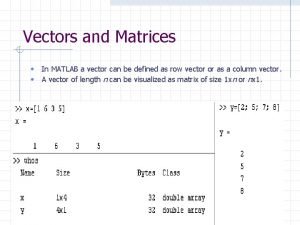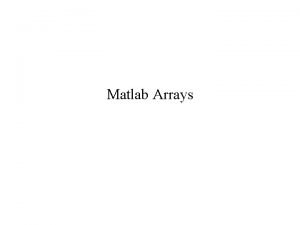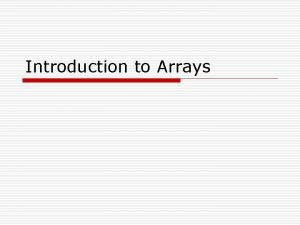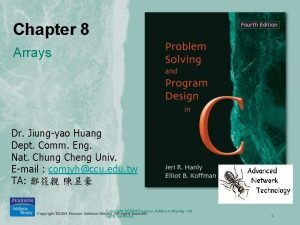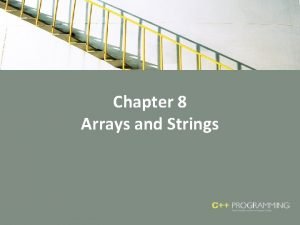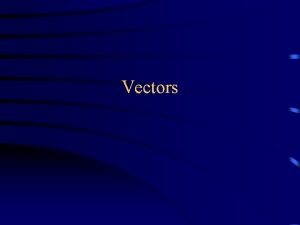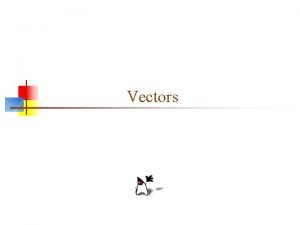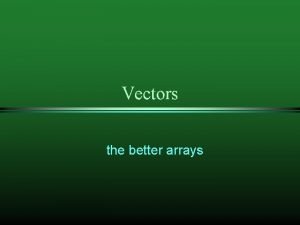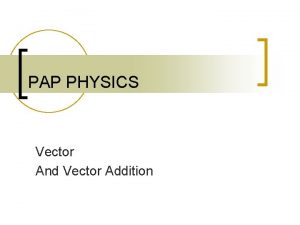Vectors Vectors and arrays A Vector is like














- Slides: 14

Vectors

Vectors and arrays • A Vector is like an array of Objects • Differences between arrays and Vectors: – Arrays have special syntax; Vectors don’t – You can have an array of any type, but a Vector holds Objects – An array is a fixed size, but a Vector expands as you add things to it • This means you don’t need to know the size beforehand

Creating a Vector • import java. util. *; • Vector vec 1 = new Vector(); • Vector vec 2 = new Vector(initial. Size); • Vector vec 3 = new Vector(initial. Size, increment);

Adding elements to a Vector • boolean add(Object o) – Appends the object o to the end of this Vector – Always returns true • This is for consistency with other, similar classes • void add(int index, Object element) – Inserts the element at position index in this Vector – The index must be greater than or equal to zero and less than or equal to the number of elements in the Vector

Removing elements from a Vector • boolean remove(Object o) – Removes the first occurrence of o from this Vector – Returns true if an element was removed • void remove(int index) – Removes the element at position index from this Vector • void remove. All. Elements() – Removes all elements

Accessing elements of a Vector • Object element. At(int index) or Object get(int index) – Returns the component at position index – element. At is an older method, retained for compatibility with older programs • Object first. Element() – Returns the component at location 0 • Object last. Element() – Returns the last component

Searching a Vector I • boolean contains(Object elem) – Tests if elem is a component of this Vector • int index. Of(Object elem) – Returns the index of the first occurrence of elem in this Vector – Returns -1 if elem was not found in this Vector • int index. Of(Object elem, int index) – Returns the index of the first occurrence of elem in this Vector, beginning the search at index – Returns -1 if elem was not found in this Vector

Searching a Vector II • int last. Index. Of(Object elem) – Returns the index of the last occurrence of elem in this Vector – Returns -1 if elem was not found in this Vector • int last. Index. Of(Object elem, int index) – Returns the index of the last occurrence of elem in this Vector, searching backward from index – Returns -1 if elem was not found in this Vector • All searching is done using equals

Getting information about a Vector • boolean is. Empty() – Returns true if this Vector has no elements • int size() – Returns the number of elements in this Vector • Object[ ] to. Array() – Returns an array containing all the elements of this Vector in the correct order

More about equals • There are many different notions of equality – Example: two sets are equal if they contain the same elements; order of elements is irrelevant • Java defines boolean equals(Object) in the Object class, but – equals is defined to be the same as == – It’s often a good idea to override equals for your own objects – The String class (and some others) override equals

A minor nuisance • Suppose you define Vector vec = new Vector(); Rabbit bunny = new Rabbit(); • You can do vec. add(bunny); • But you cannot do bunny = vec. element. At(0); • Instead, you have to do bunny = (Rabbit)vec. element. At(0);

Fixing the nuisance class Rabbit. Vector extends Vector { Rabbit element. At(int i) { return (Rabbit)super. element. At(i); } } • Now you can do Vector vec = new Rabbit. Vector(); vec. add(bunny); bunny = vec. element. At(0);

Conclusion • A Vector is like an array of Objects • The advantage of a Vector is that you don’t need to know beforehand how big to make it • The disadvantage of a Vector is that you can’t use the special syntax for arrays • You should never use an array that you hope is “big enough”--use a Vector instead

The End
 Are vectors dynamic arrays
Are vectors dynamic arrays Matlab vector of vectors
Matlab vector of vectors Initialize vector matlab
Initialize vector matlab Dynamic arrays and amortized analysis
Dynamic arrays and amortized analysis Searching and sorting arrays in c++
Searching and sorting arrays in c++ Disadvantages of random access files
Disadvantages of random access files Properties of vector
Properties of vector Coordenadas cartesianas
Coordenadas cartesianas Why is vector resolution the opposite of vector addition
Why is vector resolution the opposite of vector addition What is meant by position vector
What is meant by position vector Parallel array java
Parallel array java Array of arrays c++
Array of arrays c++ Java array operations
Java array operations Veteork
Veteork C++ parallel arrays
C++ parallel arrays

